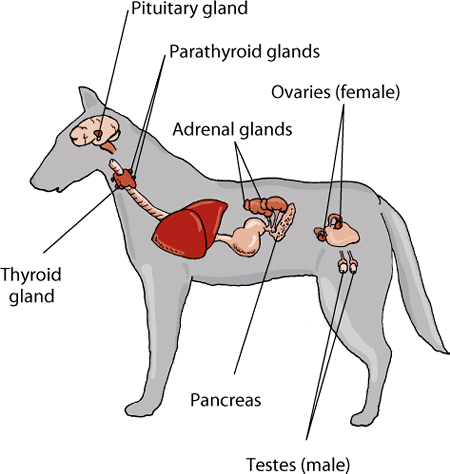Introduction to Hormonal Disorders of Dogs
- Hormonal Disorders of Dogs
- Introduction to Hormonal Disorders of Dogs
- Disorders of the Adrenal Glands in Dogs
- Disorders of the Pancreas in Dogs
- Disorders of the Parathyroid Glands and of Calcium Metabolism in Dogs
- Disorders of the Pituitary Gland in Dogs
- Disorders of the Thyroid Gland in Dogs
- Neuroendocrine Tissue Tumors in Dogs
Hormones are chemical messengers that have many different functions. The effects of hormones in the body are wide-ranging and varied. Some familiar examples of hormones include insulin, which is important in the development of diabetes, and estrogen and progesterone, which are involved in the female reproductive cycle.
The endocrine system consists of a group of tissues that release hormones into the bloodstream for travel to other parts of the body (see Table: Major Hormones). Most endocrine tissues are glands (such as the thyroid gland) that release hormones directly into small blood vessels within and around the tissue. Several important hormones are released from tissues other than glands, such as the heart, kidney, and liver. Some hormones act only on a single tissue, while others have effects on virtually every cell in the body. Hormones are present in the blood in very small quantities, so laboratory tests done to measure hormone levels must be very sensitive.
Major Hormones
Development of Endocrine System Disease
The body monitors and adjusts the level of each hormone by using a feedback system specifically for that hormone. Hormones function to keep factors such as temperature and blood sugar (glucose) levels within certain ranges. Sometimes, pairs of hormones with opposite functions work together to keep body functions in balance.
Endocrine system diseases can develop when too much or not enough hormone is produced, or when normal pathways for hormones to be used and removed are disrupted. Signs can develop because of a problem in the tissues that are the source of the hormone, or because of a problem in another part of the body that is affecting the secretion or action of a particular hormone.
A tumor or other abnormal tissue in an endocrine gland often causes it to produce too much hormone. When an endocrine gland is destroyed, not enough hormone is produced. Diseases caused by overproduction or excess of a hormone often begin with the prefix hyper. For example, in hyperthyroidism, the thyroid gland produces too much thyroid hormone. Diseases caused by a lack or deficiency of a hormone often begin with the prefix hypo. For example, in hypothyroidism, the thyroid gland does not produce enough thyroid hormone.
In many cases, the abnormal gland not only overproduces hormone, it also does not respond normally to feedback signals. This causes hormone to be released in situations in which its levels would normally be reduced. Sometimes, the overproduction is caused by stimulation from another part of the body. Occasionally, a tumor outside the endocrine system can produce a substance similar to a hormone, causing the body to respond as though that hormone were being produced.
Diseases caused by not enough hormone secretion can also have multiple causes. Endocrine tissue can be destroyed by an autoimmune process, in which the body incorrectly identifies some of its own tissue as foreign and destroys the tissue cells. In early stages of tissue loss, the body may compensate by producing additional hormone from the remaining tissue. In these cases, signs of disease may be delayed until the tissue has been destroyed completely.
Disorders resulting in signs of reduced endocrine activity may also develop because tissues distant from the hormone source are disrupted. This can occur when the function of one hormone is to stimulate the production of a second hormone. For example, the pituitary gland secretes a hormone that stimulates the thyroid gland to secrete thyroid hormones. If the levels of the thyroid-stimulating hormone from the pituitary gland are abnormally low, the levels of thyroid hormones will also be low even if the thyroid gland is healthy. Another potential cause for reduced endocrine function is tissue loss caused by tumors that do not produce hormones themselves but compress or destroy the nearby endocrine gland.
Endocrine diseases and related conditions also result from changes in the response of tissues targeted by a hormone. An important example is type 2 diabetes mellitus, in which the body produces insulin but the cells no longer respond to it. This condition is often associated with obesity.
Treatment of Endocrine System Disease
Endocrine diseases caused by the presence of too much hormone may be treated surgically (tumor removal), by radiotherapy (such as the use of radioactive iodine to destroy an overactive thyroid gland), or with medication. Syndromes of hormone deficiency are often successfully treated by replacing the missing hormone, such as insulin injections to treat diabetes mellitus. Steroid and thyroid hormone replacements can usually be given orally.
Pets taking hormone replacement treatment must be monitored for adverse effects and periodically retested to make sure the dosage is correct. In some cases, such as after surgical removal of an endocrine tumor, the diseased gland will recover and hormone replacement will no longer be needed. However, most of the time, lifelong treatment is required.
Resources In This Article
- Hormonal Disorders of Dogs
- Introduction to Hormonal Disorders of Dogs
- Disorders of the Adrenal Glands in Dogs
- Disorders of the Pancreas in Dogs
- Disorders of the Parathyroid Glands and of Calcium Metabolism in Dogs
- Disorders of the Pituitary Gland in Dogs
- Disorders of the Thyroid Gland in Dogs
- Neuroendocrine Tissue Tumors in Dogs






